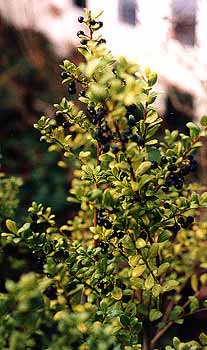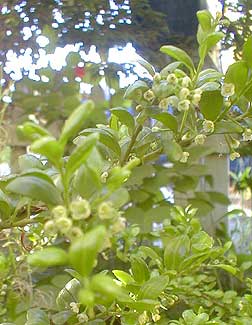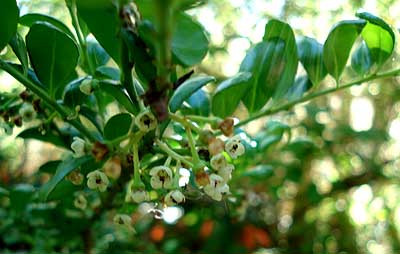
Japanese Holly,
aka Boxleafed Holly
"I said I'd pluck
A branch from the white-blossomed shrub beneath
The casement there."
-Robert Browning
(1812-1889)
(1812-1889)
 Japanese Holly (Ilex crenata) is dioecious, meaning it has two sexes, & a she-holly will not produce berries if there is no he-holly in the general vicinity.
Japanese Holly (Ilex crenata) is dioecious, meaning it has two sexes, & a she-holly will not produce berries if there is no he-holly in the general vicinity.At present we have only a she-holly, but as many hollies easily cross-pollinate with other Ilex species, I was hoping this one would continue to produce the shiny black autumn/winter berries in years to come, without requiring us to obtain a male.
It berried fine its first year in our yard, but of course it was pollinated in the grower's fields before we obtained it.
It did not berry in years to follow, alas, so of the many different hollies growing throughout the neighborhood, none were pollinating this one. I suppose I'll eventually break down & obtain a male, as I do enjoy the look of those berries.
This she-holly was initially planted near the water faucet, as it can tolerate the dampness inevitable in that location, & it is tough enough to endure a little bit of wacking from hoses.
 But at some point a few years ago I dug it up & put it in a large decorative pot, where it's done just as well, even if I forget sometimes to keep it watered.
But at some point a few years ago I dug it up & put it in a large decorative pot, where it's done just as well, even if I forget sometimes to keep it watered.The leaves are not sharp as on English holly, so a garden chair backed up against the shrub doesn't put anyone seated by it at risk of scratches.
The leaves are more like those on box shrubs, but the shrub is hardier than boxwood, & overall more interesting than boxes, especially if it berries which last all winter long & well into spring.
Japanese Holly does well in shade or part sun, has the beautiful black berries all winter & well into spring. It has tiny white flowers May through July, not very decorative or visible under the limbs. On some varieties the black berries are rather hidden among the leaves, too, but on ours they were positioned among the leaves with considerable impact.
Although the species grows to fifteen feet or even larger, garden cultivars are mostly small. Ours was unlabeled as to cultivar, but I believe it to be "Mariesii," notable for producing many black winter berries.
It grows rigidly upright, however slowly, to six & a half feet, remaining narrow. It can be minimally trimmed & easily trained into a miniature tree. Ours in six or seven years is still only about three feet tall & wide, four feet tall counting the wide pot.
See also the article about European & Japanese
Holly Mythology.